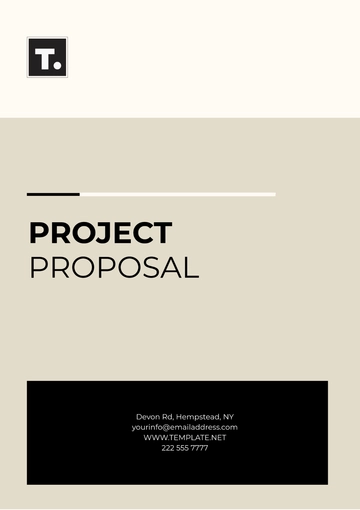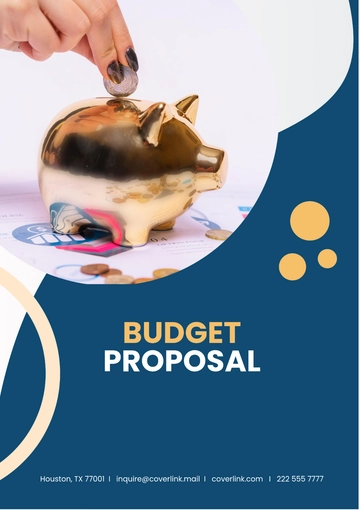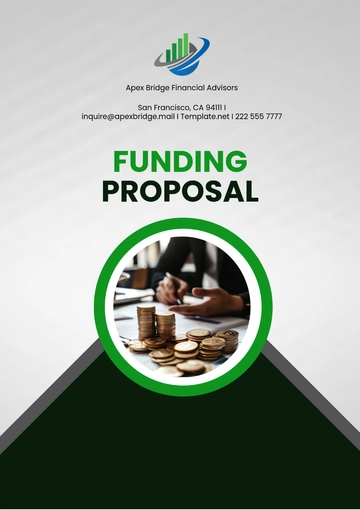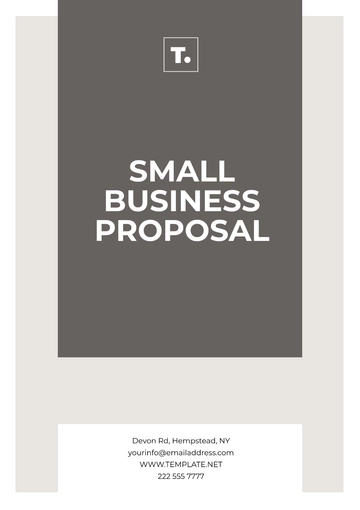Free Agriculture Financial Proposal
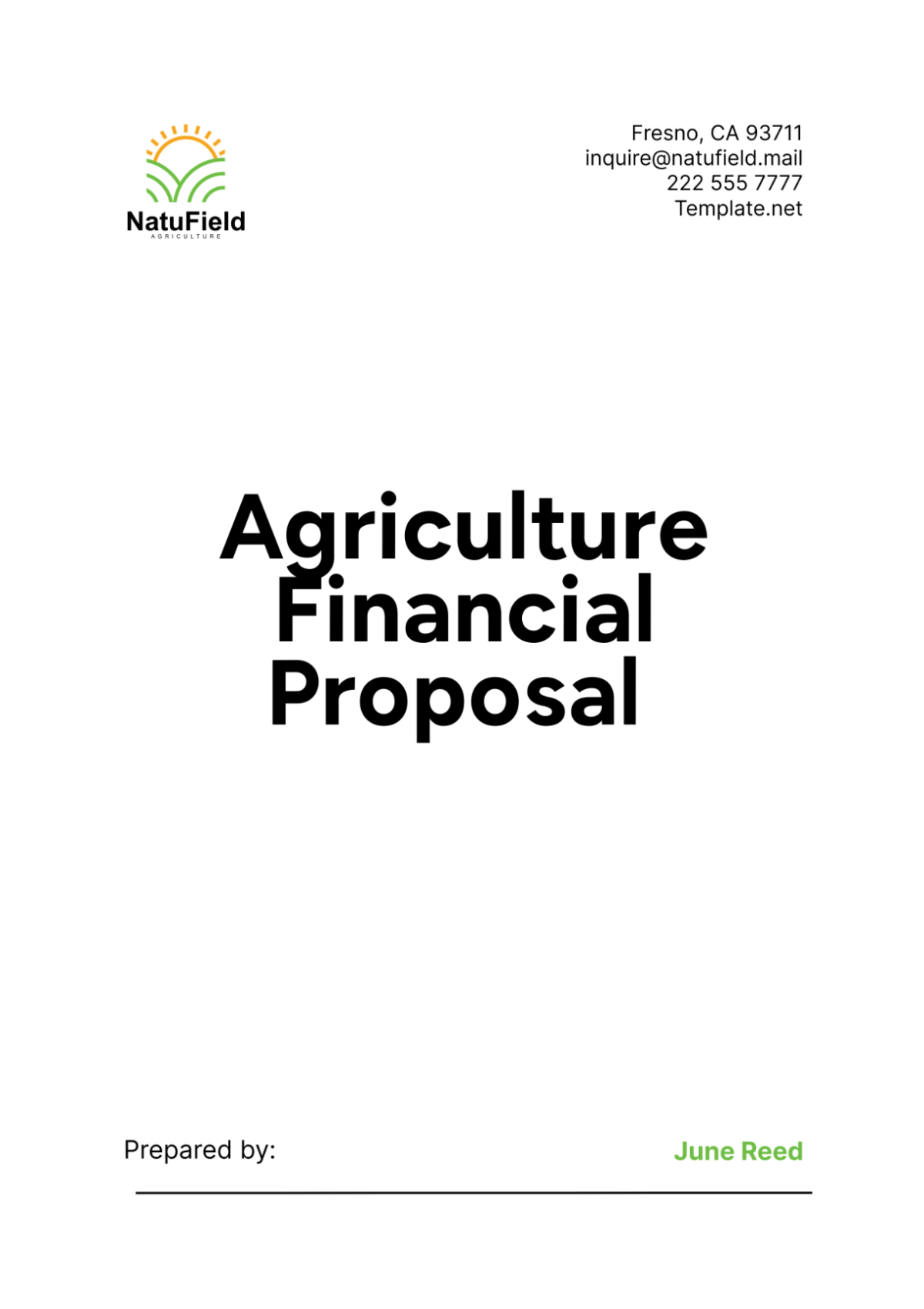
I. Executive Summary
A. Overview of [Your Company Name]
[Your Company Name] is a leading agricultural enterprise dedicated to sustainable farming practices and innovative agricultural solutions. Our primary focus is on producing high-quality crops and livestock while maximizing profitability and ensuring long-term sustainability. With a history of excellence in the agricultural sector, we aim to continue our legacy by implementing a robust financial strategy that supports our growth and operational efficiency.
B. Purpose of the Financial Proposal
The purpose of this agriculture financial proposal is to present a comprehensive financial plan for [Your Company Name] that outlines our income projections, expense forecasts, capital investment needs, and risk management strategies. This proposal aims to secure funding, attract potential investors, and ensure financial stability for our agricultural operations. By providing detailed financial analysis and strategic planning, we seek to achieve our short-term and long-term financial goals.
C. Summary of Financial Goals and Objectives
Our primary financial goals are to increase revenue through diversified income sources, optimize operational expenses, and enhance our capital infrastructure. We aim to achieve a net profit margin of at least 25% annually and ensure a return on investment (ROI) of over 30%. Our strategic financial objectives include expanding our land holdings, upgrading equipment and machinery, and investing in research and development to stay competitive and innovative in the agricultural industry.
II. Introduction
A. Background and History of Agricultural Operations
[Your Company Name] was established with a vision to revolutionize the agricultural sector through sustainable farming practices and cutting-edge technology. Over the years, we have expanded our operations to include a variety of crops and livestock, catering to both domestic and international markets. Our commitment to quality and innovation has earned us a reputation as a trusted and reliable agricultural producer.
B. Current Financial Status
Currently, [Your Company Name] is financially stable with steady revenue streams from crop and livestock production. Our financial health is bolstered by strategic investments in modern farming equipment and infrastructure improvements. Despite facing challenges such as market fluctuations and environmental risks, our prudent financial management has ensured consistent profitability and growth.
C. Importance of Financial Planning in Agriculture
Effective financial planning is crucial in agriculture due to the inherent risks and uncertainties in the industry. From unpredictable weather patterns to volatile market prices, various factors can impact agricultural operations. A well-structured financial plan enables us to mitigate risks, allocate resources efficiently, and make informed decisions that drive growth and sustainability. This financial proposal outlines our strategic approach to managing finances and achieving long-term success.
III. Financial Objectives
A. Short-term Financial Goals
In the short term, our primary financial goals include:
Achieving a 10% increase in revenue from crop production within the next fiscal year.
Reducing operational expenses by 5% through cost-saving measures and improved efficiency.
Securing funding for immediate capital investments in land acquisition and equipment upgrades.
B. Long-term Financial Goals
Our long-term financial goals are focused on sustainable growth and profitability:
Expanding our agricultural land holdings by 20% over the next five years to increase production capacity.
Achieving a net profit margin of at least 25% annually through diversified income streams and efficient operations.
Investing in research and development to innovate and improve our farming practices, ensuring long-term competitiveness.
C. Strategic Financial Priorities
Our strategic financial priorities include:
Diversifying income sources by exploring new crop varieties, value-added products, and agri-tourism opportunities.
Enhancing operational efficiency through investments in modern farming equipment and technology.
Implementing robust risk management strategies to safeguard against environmental, market, and operational risks.
IV. Income Projections
A. Crop Production Income
Crop production is a significant revenue stream for [Your Company Name]. We cultivate a variety of crops, including wheat, corn, soybeans, and vegetables. Our income projections for crop production are based on expected yield and market pricing.
Types of Crops
Our primary crops include wheat, corn, and soybeans, each contributing significantly to our revenue. Additionally, we grow high-value vegetables such as tomatoes, peppers, and lettuce for local and regional markets.
Expected Yield and Pricing
We anticipate a yield of 50 bushels per acre for wheat, 150 bushels per acre for corn, and 45 bushels per acre for soybeans. Market prices are projected to be $5 per bushel for wheat, $4 per bushel for corn, and $10 per bushel for soybeans.
Table 1: Crop Production Income Projections
Crop | Acreage | Expected Yield (bushels/acre) | Market Price ($/bushel) | Total Income ($) |
|---|---|---|---|---|
Wheat | 500 | 50 | 5 | 125,000 |
Corn | 300 | 150 | 4 | 180,000 |
Soybeans | 200 | 45 | 10 | 90,000 |
Vegetables | 100 | 80,000 | ||
Total | 1100 | 475,000 |
B. Livestock Production Income
Livestock production is another vital component of our revenue. We raise cattle, poultry, and pigs, with each category contributing to our income projections.
Types of Livestock
Our livestock operations include beef cattle, broiler chickens, and pigs. We focus on high-quality breeding and efficient feeding practices to maximize yield and profitability.
Expected Yield and Pricing
We anticipate selling 200 head of cattle, 10,000 broiler chickens, and 500 pigs annually. Market prices are projected to be $1,200 per head for cattle, $5 per chicken, and $250 per pig.
Table 2: Livestock Production Income Projections
Livestock | Quantity | Market Price ($/unit) | Total Income ($) |
|---|---|---|---|
Cattle | 200 | 1,200 | 240,000 |
Chickens | 10,000 | 5 | 50,000 |
Pigs | 500 | 250 | 125,000 |
Total | 415,000 |
C. Additional Income Sources
To diversify our income, we explore various additional revenue streams, including agri-tourism, value-added products, and grants/subsidies.
Agri-tourism
Agri-tourism activities such as farm tours, workshops, and seasonal events attract visitors and generate additional income. We project an annual income of $50,000 from agri-tourism.
Value-added Products
We produce value-added products such as organic fertilizers, processed foods, and artisanal goods. These products are expected to generate $75,000 annually.
Grants and Subsidies
We actively seek grants and subsidies from government programs and agricultural organizations. We anticipate receiving $30,000 annually in grants and subsidies.
Table 3: Additional Income Projections
Source | Annual Income ($) |
|---|---|
Agri-tourism | 50,000 |
Value-added Products | 75,000 |
Grants and Subsidies | 30,000 |
Total | 155,000 |
V. Expense Forecasts
A. Crop Production Expenses
Crop production expenses include costs for seeds, fertilizers, labor, and equipment maintenance.
Seeds and Fertilizers
The cost of seeds and fertilizers is estimated based on the acreage and type of crops grown. We project an annual expenditure of $50,000 for seeds and $30,000 for fertilizers.
Labor Costs
Labor costs encompass wages for farm workers involved in planting, tending, and harvesting crops. We anticipate an annual labor cost of $60,000 for crop production.
Equipment Maintenance
Maintaining and repairing farming equipment is essential for efficient operations. We project an annual equipment maintenance cost of $25,000.
Table 4: Crop Production Expense Forecasts
Expense | Annual Cost ($) |
|---|---|
Seeds | 50,000 |
Fertilizers | 30,000 |
Labor | 60,000 |
Equipment Maintenance | 25,000 |
Total | 165,000 |
B. Livestock Production Expenses
Livestock production expenses include feed, healthcare, labor, and equipment/facility maintenance.
Feed and Healthcare
The cost of feed and healthcare for livestock is projected to be $75,000 annually. This includes feed purchases and veterinary services.
Labor Costs
Labor costs for livestock production include wages for workers involved in animal care and management. We anticipate an annual labor cost of $50,000.
Equipment and Facility Maintenance
Maintaining livestock equipment and facilities is crucial for ensuring animal health and productivity. We project an annual maintenance cost of $20,000.
Table 5: Livestock Production Expense Forecasts
Expense | Annual Cost ($) |
|---|---|
Feed and Healthcare | 75,000 |
Labor | 50,000 |
Equipment Maintenance | 20,000 |
Total | 145,000 |
C. General Farm Operation Expenses
General farm operation expenses cover utilities, insurance, transportation, and administrative costs.
Utilities and Insurance
Utility costs include water, electricity, and fuel for farm operations. Insurance covers crop and livestock insurance, liability insurance, and property insurance. We project an annual cost of $40,000 for utilities and $30,000 for insurance.
Transportation and Logistics
Transportation costs include fuel and maintenance for vehicles used in transporting crops and livestock. We anticipate an annual transportation cost of $20,000.
Administrative Costs
Administrative costs encompass office supplies, software, and professional services such as accounting and legal fees. We project an annual administrative cost of $15,000.
Table 6: General Farm Operation Expense Forecasts
Expense | Annual Cost ($) |
|---|---|
Utilities | 40,000 |
Insurance | 30,000 |
Transportation | 20,000 |
Administrative Costs | 15,000 |
Total | 105,000 |
VI. Capital Investment Needs
A. Land Acquisition
Expanding our agricultural land holdings is a critical investment to increase production capacity. We plan to acquire an additional 500 acres of farmland at an estimated cost of $1,000,000.
B. Equipment Upgrades
Investing in modern farming equipment is essential for enhancing operational efficiency. We plan to purchase new tractors, harvesters, and irrigation systems at an estimated cost of $500,000.
C. Infrastructure Improvements
Improving infrastructure, such as storage facilities, greenhouses, and livestock shelters, is vital for maintaining the quality and safety of our products. We project an investment of $300,000 for infrastructure improvements.
D. Research and Development
Investing in research and development enables us to innovate and improve our farming practices. We plan to allocate $200,000 for R&D initiatives focused on sustainable farming techniques and new crop varieties.
Table 7: Capital Investment Needs
Investment Area | Estimated Cost ($) |
|---|---|
Land Acquisition | 1,000,000 |
Equipment Upgrades | 500,000 |
Infrastructure Improvements | 300,000 |
Research and Development | 200,000 |
Total | 2,000,000 |
VII. Risk Management
A. Environmental Risks
Agriculture is inherently affected by environmental factors such as weather conditions, pests, and diseases. To mitigate these risks, we implement sustainable farming practices, invest in advanced irrigation systems, and use integrated pest management techniques.
B. Market Risks
Fluctuations in market prices for crops and livestock can impact our revenue. We mitigate market risks by diversifying our income sources, establishing long-term contracts with buyers, and participating in futures markets to lock in prices.
C. Operational Risks
Operational risks include equipment failures, labor shortages, and logistical challenges. We manage these risks through regular maintenance of equipment, training programs for employees, and efficient supply chain management.
D. Financial Risks
Financial risks involve changes in interest rates, credit availability, and liquidity. We mitigate financial risks by maintaining a strong cash reserve, securing favorable loan terms, and diversifying our investment portfolio.
Table 8: Risk Management Strategies
Risk Area | Mitigation Strategy |
|---|---|
Environmental Risks | Sustainable practices, advanced irrigation, pest management |
Market Risks | Income diversification, long-term contracts, futures markets |
Operational Risks | Equipment maintenance, employee training, supply chain management |
Financial Risks | Cash reserves, favorable loan terms, investment diversification |
VIII. Financial Analysis
A. Profit and Loss Statement
Our profit and loss statement provides a detailed overview of our projected income and expenses, illustrating our net profit for the upcoming fiscal year.
Table 9: Projected Profit and Loss Statement
Category | Amount ($) |
|---|---|
Income | |
Crop Production | 475,000 |
Livestock Production | 415,000 |
Additional Income | 155,000 |
Total Income | 1,045,000 |
Expenses | |
Crop Production | 165,000 |
Livestock Production | 145,000 |
General Operations | 105,000 |
Total Expenses | 415,000 |
Net Profit | 630,000 |
B. Cash Flow Statement
Our cash flow statement outlines the inflows and outflows of cash, ensuring we maintain sufficient liquidity for our operations.
Table 10: Projected Cash Flow Statement
Category | Amount ($) |
|---|---|
Cash Inflows | |
Sales Revenue | 1,045,000 |
Total Inflows | 1,045,000 |
Cash Outflows | |
Operating Expenses | 415,000 |
Capital Investments | 2,000,000 |
Total Outflows | 2,415,000 |
Net Cash Flow | (1,370,000) |
C. Balance Sheet
Our balance sheet provides a snapshot of our financial position, including assets, liabilities, and equity.
Table 11: Projected Balance Sheet
Category | Amount ($) |
|---|---|
Assets | |
Current Assets | 500,000 |
Fixed Assets | 3,500,000 |
Total Assets | 4,000,000 |
Liabilities | |
Current Liabilities | 300,000 |
Long-term Liabilities | 1,500,000 |
Total Liabilities | 1,800,000 |
Equity | |
Owner's Equity | 2,200,000 |
Total Equity | 2,200,000 |
D. Financial Ratios
Financial ratios provide insights into our financial health and performance, helping us make informed decisions.
Table 12: Key Financial Ratios
Ratio | Value |
|---|---|
Current Ratio | 1.67 |
Debt-to-Equity Ratio | 0.82 |
Net Profit Margin | 60.29% |
Return on Investment | 31.50% |
IX. Funding Requirements
A. Short-term Funding Needs
To meet our immediate financial goals, we require short-term funding for capital investments and operational expenses. We seek to raise $1,000,000 through short-term loans and grants.
B. Long-term Funding Needs
For long-term growth and expansion, we need additional funding for land acquisition, equipment upgrades, and infrastructure improvements. We aim to raise $2,000,000 through equity financing, long-term loans, and strategic partnerships.
C. Funding Sources
We plan to secure funding from various sources, including banks, agricultural finance institutions, government grants, and private investors. We will also explore opportunities for crowdfunding and community-based funding initiatives.
Table 13: Funding Requirements and Sources
Funding Need | Amount ($) | Funding Source |
|---|---|---|
Short-term Capital | 1,000,000 | Short-term loans, grants |
Long-term Capital | 2,000,000 | Equity financing, long-term loans |
Total Funding Required | 3,000,000 |
X. Conclusion
A. Summary of Financial Proposal
This financial proposal for [Your Company Name] outlines a comprehensive plan to achieve our financial goals and ensure the sustainability and growth of our agricultural operations. By detailing our income projections, expense forecasts, capital investment needs, and risk management strategies, we provide a clear roadmap for financial success.
B. Call to Action for Investors and Stakeholders
We invite investors, financial institutions, and stakeholders to support our vision and contribute to the future of sustainable agriculture. By investing in [Your Company Name], you are not only supporting a profitable enterprise but also promoting innovative and environmentally responsible farming practices.
C. Future Outlook and Vision
With the implementation of this financial plan, [Your Company Name] is poised for continued growth and success. Our commitment to excellence, sustainability, and innovation will drive us forward as a leader in the agricultural industry. Together, we can achieve our financial goals and make a positive impact on the future of farming.
- 100% Customizable, free editor
- Access 1 Million+ Templates, photo’s & graphics
- Download or share as a template
- Click and replace photos, graphics, text, backgrounds
- Resize, crop, AI write & more
- Access advanced editor
Secure funding with Template.net's customizable and editable Agriculture Financial Proposal Template. Utilize the Ai Editor Tool to tailor this template to your financial needs. Ideal for creating compelling financial proposals to attract investors and secure funding for agricultural projects.
You may also like
- Business Proposal
- Research Proposal
- Proposal Request
- Project Proposal
- Grant Proposal
- Photography Proposal
- Job Proposal
- Budget Proposal
- Marketing Proposal
- Branding Proposal
- Advertising Proposal
- Sales Proposal
- Startup Proposal
- Event Proposal
- Creative Proposal
- Restaurant Proposal
- Blank Proposal
- One Page Proposal
- Proposal Report
- IT Proposal
- Non Profit Proposal
- Training Proposal
- Construction Proposal
- School Proposal
- Cleaning Proposal
- Contract Proposal
- HR Proposal
- Travel Agency Proposal
- Small Business Proposal
- Investment Proposal
- Bid Proposal
- Retail Business Proposal
- Sponsorship Proposal
- Academic Proposal
- Partnership Proposal
- Work Proposal
- Agency Proposal
- University Proposal
- Accounting Proposal
- Real Estate Proposal
- Hotel Proposal
- Product Proposal
- Advertising Agency Proposal
- Development Proposal
- Loan Proposal
- Website Proposal
- Nursing Home Proposal
- Financial Proposal
- Salon Proposal
- Freelancer Proposal
- Funding Proposal
- Work from Home Proposal
- Company Proposal
- Consulting Proposal
- Educational Proposal
- Construction Bid Proposal
- Interior Design Proposal
- New Product Proposal
- Sports Proposal
- Corporate Proposal
- Food Proposal
- Property Proposal
- Maintenance Proposal
- Purchase Proposal
- Rental Proposal
- Recruitment Proposal
- Social Media Proposal
- Travel Proposal
- Trip Proposal
- Software Proposal
- Conference Proposal
- Graphic Design Proposal
- Law Firm Proposal
- Medical Proposal
- Music Proposal
- Pricing Proposal
- SEO Proposal
- Strategy Proposal
- Technical Proposal
- Coaching Proposal
- Ecommerce Proposal
- Fundraising Proposal
- Landscaping Proposal
- Charity Proposal
- Contractor Proposal
- Exhibition Proposal
- Art Proposal
- Mobile Proposal
- Equipment Proposal
- Student Proposal
- Engineering Proposal
- Business Proposal
